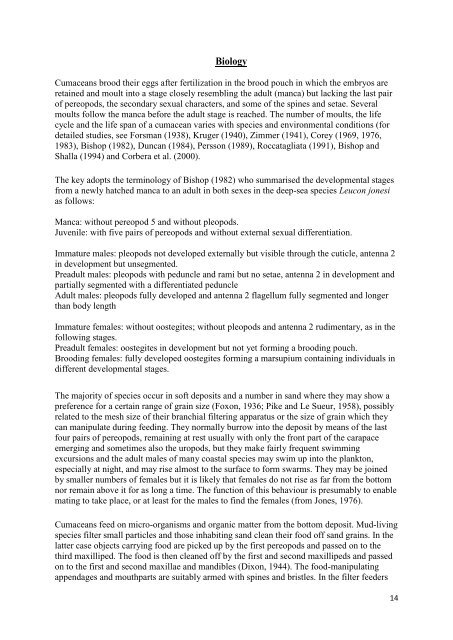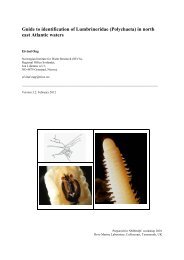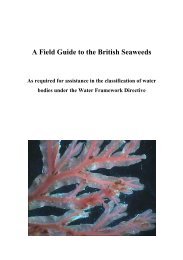Create successful ePaper yourself
Turn your PDF publications into a flip-book with our unique Google optimized e-Paper software.
Biology<br />
Cumaceans brood their eggs after fertilization in the brood pouch in which the embryos are<br />
retained and moult into a stage closely resembling the adult (manca) but lacking the last pair<br />
of pereopods, the secondary sexual characters, and some of the spines and setae. Several<br />
moults follow the manca before the adult stage is reached. The number of moults, the life<br />
cycle and the life span of a cumacean varies with species and environmental conditions (for<br />
detailed studies, see Forsman (1938), Kruger (1940), Zimmer (1941), Corey (1969, 1976,<br />
1983), Bishop (1982), Duncan (1984), Persson (1989), Roccatagliata (1991), Bishop and<br />
Shalla (1994) and Corbera et al. (2000).<br />
The key adopts the terminology of Bishop (1982) who summarised the developmental stages<br />
from a newly hatched manca to an adult in both sexes in the deep-sea species Leucon jonesi<br />
as follows:<br />
Manca: without pereopod 5 and without pleopods.<br />
Juvenile: with five pairs of pereopods and without external sexual differentiation.<br />
Immature males: pleopods not developed externally but visible through the cuticle, antenna 2<br />
in development but unsegmented.<br />
Preadult males: pleopods with peduncle and rami but no setae, antenna 2 in development and<br />
partially segmented with a differentiated peduncle<br />
Adult males: pleopods fully developed and antenna 2 flagellum fully segmented and longer<br />
than body length<br />
Immature females: without oostegites; without pleopods and antenna 2 rudimentary, as in the<br />
following stages.<br />
Preadult females: oostegites in development but not yet forming a brooding pouch.<br />
Brooding females: fully developed oostegites forming a marsupium containing individuals in<br />
different developmental stages.<br />
The majority of species occur in soft deposits and a number in sand where they may show a<br />
preference for a certain range of grain size (Foxon, 1936; Pike and Le Sueur, 1958), possibly<br />
related to the mesh size of their branchial filtering apparatus or the size of grain which they<br />
can manipulate during feeding. They normally burrow into the deposit by means of the last<br />
four pairs of pereopods, remaining at rest usually with only the front part of the carapace<br />
emerging and sometimes also the uropods, but they make fairly frequent swimming<br />
excursions and the adult males of many coastal species may swim up into the plankton,<br />
especially at night, and may rise almost to the surface to form swarms. They may be joined<br />
by smaller numbers of females but it is likely that females do not rise as far from the bottom<br />
nor remain above it for as long a time. The function of this behaviour is presumably to enable<br />
mating to take place, or at least for the males to find the females (from Jones, 1976).<br />
Cumaceans feed on micro-organisms and organic matter from the bottom deposit. Mud-living<br />
species filter small particles and those inhabiting sand clean their food off sand grains. In the<br />
latter case objects carrying food are picked up by the first pereopods and passed on to the<br />
third maxilliped. The food is then cleaned off by the first and second maxillipeds and passed<br />
on to the first and second maxillae and mandibles (Dixon, 1944). The food-manipulating<br />
appendages and mouthparts are suitably armed with spines and bristles. In the filter feeders<br />
14




